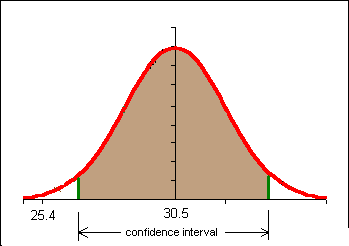Saturday, August 25, 2007
More on Erratic Polls from Political Wire

A few days ago, Howling Latina mentioned that polls can be misleading due to sample size.
Well, as the goodlord would have it, Taegan Goddard's Political Wire has a post on the subject today.
As one can see, it's within the margin of error that Virginians favor Webb by 52.5 percent and Warner by an identical 52.5 percent.
In July, Webb registered a 46.5 - 55.5 percent favorable rating among Virginians with a 95 percent confidence level and Warner registered a 48.5 - 57.5 with a 95 percent confidence level. This means with a 95 percent probability, Virginians might've favored Webb over Warner in July, 55.5 to 48.5 percent.
When gaging support in the subgroups, the polls are pretty meaningless as Political Wire explains.
Well, as the goodlord would have it, Taegan Goddard's Political Wire has a post on the subject today.
Now, using the same formula for Webb's SurveyUSA favorability poll in August, there is a 95 percent probability that Webb is supported by 43.5 - 52.5 percent of Virginians. Likewise, there is an 95 percent probability that Warner is supported by 52.5 - 61.5 percent.Taegan recently linked to a Zogby International poll of likely Republican Iowa caucus-goers showing Mitt Romney leading Rudy Giuliani 33%-14%. The poll had a sample size of 487, yeilding a margin of error of about +/- 4.5 percentage points. In other words, there is a 95% probability that Mitt Romney is supported by 28.5%-37.5% of likely Republican Iowa caucus-goers. And there is a 95% probability that Rudy Giuliani is supported by 9.5%-18.5% of likely Republican Iowa caucus-goers. That's means that we can be pretty confident that Romney is leading in Iowa (assuming no error except sampling error), since these "confidence intervals" do not overlap.
As one can see, it's within the margin of error that Virginians favor Webb by 52.5 percent and Warner by an identical 52.5 percent.
In July, Webb registered a 46.5 - 55.5 percent favorable rating among Virginians with a 95 percent confidence level and Warner registered a 48.5 - 57.5 with a 95 percent confidence level. This means with a 95 percent probability, Virginians might've favored Webb over Warner in July, 55.5 to 48.5 percent.
When gaging support in the subgroups, the polls are pretty meaningless as Political Wire explains.
Zogby then says that Romney is leading in many age groups. For example, among 35-54 year-olds, he holds an 11-point lead over Giuliani. But the size of this subgroup (middle age people) is much smaller, meaning that the margin of error is much larger. Although the press release does not divulge internals, let us suppose that 35-54 year-olds comprise about 20% of the sample, yeilding a sample size of 100. According to Census figures, that's generous: 35-54 year-olds actually make up closer to 15% of the population. Nevertheless, a sample size of 100 yields a margin of error of +/- 10 percentage points, easily encompassing the 11-point lead.